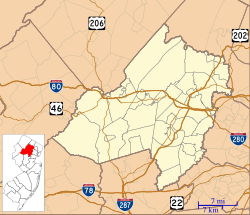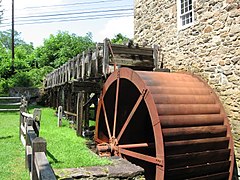Nathan Cooper Gristmill
Nathan Cooper Gristmill | |
 Nathan Cooper Gristmil in 2019 | |
| Location | 66 NJ Route 24 Chester Township, New Jersey |
|---|---|
| Coordinates | 40°46′44″N 74°43′16″W / 40.77889°N 74.72111°W |
| Area | 1 acre (0.40 ha) |
| Built | 1826 |
| NRHP reference No. | 76001174[1] |
| NJRHP No. | 2101[2] |
| Significant dates | |
| Added to NRHP | November 21, 1976 |
| Designated NJRHP | November 25, 1975 |
The Nathan Cooper Gristmill is a historic gristmill on the Black River located at 66 NJ Route 24 in Chester Township, Morris County, New Jersey.[3] It was added to the National Register of Historic Places on November 21, 1976 for its significance in industry.[4]
Since 1973, the Morris County Park Commission has owned and operated the mill and its 14 surrounding acres as a historic site.[3]
History[edit]
18th century[edit]
Circa the 1760s, county judge Isaiah Younglove[5] constructed a no-longer-extant mill on the Black River.[6] Younglove's mill began flour milling production on the site. Images of America: Chester claims Younglove's mill burned down in an unspecified year,[5] while the Morris County Park Commission describes his endeavor as having shut down in 1788.[3] The mill then went through several owners before 1825. The last owner prior to the Coopers was Elias Howell.[7]
19th century heyday[edit]
In 1825, retired general Nathan Cooper (1751–1834) purchased the 4.5 acres of land for $750.[3][8] This included "a milldam, sawmill, an old gristmill, and [a wooden] water wheel."[9] This was an addition to his wealth, as he too had the ownership of over 1600 acres of land[10] including multiple mines under Cooper, Hewitt, & Co.[11]
The following year, Cooper rebuilt the mill, constructing a four-story random fieldstone gristmill to replace the 1760s structure.[3][9][12] The new building employed the use of "four sets of millstones connected by elevators to grain cleaners and flour sifters." These incorporated the designs of American inventor Oliver Evans.[13] The mill could grind up to 10 tons per day of wheat, corn, and other grains.[3] Also in 1826, Nathan Cooper gave the property to his adult nephew, Nathan A. Cooper, who had become a NJ cavalry general 2 years before.[9]
In 1827 and 1829, Nathan Cooper "raised the height of the dam as it stood."[8]
Nathan A. Cooper commissioned a house to be constructed nearby for his son, Abram W. Cooper (1848–1933) as a wedding present.[14][9]
In the 1870s, the Coopers installed modern turbines to replace the original wooden waterwheels.[3]
Upon Nathan A. Cooper's 1879 death, Abram W. Cooper (one of his nine children) inherited ownership of the mill.[9] Abram W. Cooper was described contemporaneously as a man whose "life had been quiet and uneventful, but upright and honorable...devoted to his business interests and the requirements of citizenship."[15]
Later, Nathan A. Cooper (1802–1879) inherited this mill when his uncle Nathan died.[16]
In the 1880s, Milltown experienced bustling economic success, and the Cooper mill "played a key role in the community and the region's industrial development." The mill shared Main Street with "a blacksmith shop, a general store, a tavern...and the Mountain Spring Distillery, a cider mill." The Coopers used their growing wealth to build family mansions in nearby Chester.[17]
The mill continued to grind grain into flour until 1913.[9]
20th century[edit]
On January 31, 1913, the Milltown general store across the street burned down in a fire. The same year, the mill ceased to operate.[9] In an unknown year, the Old Mill Tavern pub was built atop the site of the Milltown general store.[5]
Museum conversion[edit]
In 1973, the Morris County Park Commission acquired the mill.[3] After the acquisition, the mill was restored[12] and Abram Cooper's home was converted into a Visitors' Center.[9] The site opened to the public in October 1978.[3] Visitors of the mill museum take home "stone-ground flour and cornmeal produced at the Gristmill."[3]
After its acquisition in 1973, the Morris County Park Commission converted the Abram Cooper home into a Visitors' Center.[9] The mill has since been kept in operating condition, being preserved as it was in the 1880s "with some updates" including the addition of electricity and a new water wheel.[6] Its current wheel is an "all-steel-Fitz Company waterwheel"[3] from 1927.[6]
During Hurricane Irene in 2011, multiple local rivers flooded including the Black River. However, the mill was left undamaged due to its strategic elevated placement to avoid flooding, a feature of most historic mills.[6]
In 2010, it was New Jersey's only restored water-powered mill.[18] This claim was falsified by the 2020 restoration of the Red Mill in Clinton, New Jersey.[19]
The Friends of Fosterfields and Cooper Gristmill, a non-profit organization, contributes money and expertise to run the mill.[20] It is open April through October and offers several educational programs and summer camps.[6]
Gallery[edit]
-
Steel water wheel
-
View along the mill race
-
Morris County historical information
-
Visitors' center
See also[edit]
- National Register of Historic Places listings in Morris County, New Jersey
- General Nathan Cooper Mansion
References[edit]
- ^ "National Register Information System – (#76001174)". National Register of Historic Places. National Park Service. November 2, 2013.
- ^ "New Jersey and National Registers of Historic Places - Morris County" (PDF). New Jersey Department of Environmental Protection - Historic Preservation Office. December 28, 2020. p. 3.
- ^ a b c d e f g h i j k "Cooper Gristmill". Morris County Park Commission.
- ^ Kostrub, Nanci (November 21, 1976). "National Register of Historic Places Inventory/Nomination: Nathan Cooper Gristmill". National Park Service. With accompanying photo from 1976
- ^ a b c Case, Joan S. (1998). Chester. Arcadia Publishing. ISBN 978-0-7385-5468-6.
- ^ a b c d e Collections (2014-03-18). Collections Vol 10 N1. Rowman & Littlefield. p. 69. ISBN 978-1-4422-6788-6.
- ^ National Register of Historic Places form - Cooper Gristmill, 1974.
- ^ a b Zabriskie, C. (1866). "Cooper v. Carlisle, 17 N.J. Eq. 525". cite.case.law. Retrieved 2023-03-28.
- ^ a b c d e f g h i Weber, Gioia. "Milltown Area". Chester Historical Society.
- ^ A History of Morris County, New Jersey: Embracing Upwards of Two Centuries, 1710-1913 ... Lewis Historical Publishing Company. 1914. p. 178.
- ^ NJDEP - NJGS - Annual Report of the State Geologist for the year 1880
- ^ a b Rosenfeld, Lucy D.; Harrison, Marina (2006). History Walks in New Jersey: Exploring the Heritage of the Garden State. Rutgers University Press. ISBN 978-0-8135-3969-0.
- ^ Goodspeed, Diane (2005). Family-Friendly Biking in New Jersey and Eastern Pennsylvania. Rutgers University Press. ISBN 978-0-8135-3574-6.
- ^ "Fall Foliage Tours in New Jersey". www.njskylands.com. Retrieved 2023-03-28.
- ^ "Abram W. Cooper". Biographical and Genealogical History of Morris County, N.J. Lewis Publishing Company. 1899.
- ^ Greenidge, Frances (1974). "Nathan A. Cooper". Chester, New Jersey: A Scrapbook of History. Chester, New Jersey: Chester Historical Society. pp. 52–3.
- ^ "Milltown - A 19th Century Village Historical Marker". www.hmdb.org. Retrieved 2023-03-28.
- ^ Cantele, Andi Marie; Kaplan, Mitch (2010-03-01). Explorer's Guide New Jersey (Second ed.). The Countryman Press. ISBN 978-1-58157-904-8.
- ^ NJ.com, Caroline Fassett | NJ Advance Media for (2020-09-09). "After a 3-year break, the big wheel at the Red Mill will keep on turning". nj. Retrieved 2023-10-08.
- ^ "Friends of Fosterfields and Cooper Gristmill".
External links[edit]
- Official website

- "Cooper Gristmill". The Historical Marker Database.
- Chester Township, New Jersey
- Industrial buildings completed in 1826
- Buildings and structures in Morris County, New Jersey
- National Register of Historic Places in Morris County, New Jersey
- New Jersey Register of Historic Places
- 1826 establishments in New Jersey
- Museums in Morris County, New Jersey
- Mill museums in the United States
- Grinding mills on the National Register of Historic Places in New Jersey








